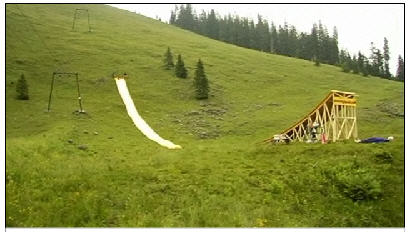-
How I Got Punked by the Megawoosh Waterslide Video
In last Friday's "4 Items Worth Noting..." post, I made a quick reference to the Megawoosh Waterslide video - what I thought was a genuine user-generated video of a German man barreling down a huge waterslide into a small pool. It turns out that I, along with many others, got punked. It's a fake, created through effects by a German marketing firm and sponsored by Microsoft Office. If you want all the details, NewTeeVee has a great write-up.
The waterslide incident contrasts with a second incident that happened to me just two weeks earlier. Taken together, I think the two represent a fascinating, yet unexplored side-effect of the broadband video revolution that all of us as human beings are currently experiencing. Let me explain what I mean.
In July 31st VideoNuze Report podcast, Daisy Whitney was very excited to describe the "JK Wedding March" viral video phenomenon (19 million + views to date) and how YouTube was publicizing on its blog that it was generating exceptional click-throughs and revenue for the video's background song "Forever" by Chris Brown through overlay ads.
When I quickly watched the video, my internal "authenticity detector" went off loudly as I wondered whether the wedding march was authentic or simply staged to generated buzz and sales for the song. I expressed this skepticism to Daisy on the podcast, and it wasn't until I did further research, and found the young Minnesota wedding couple interviewed on the "Today" show that my suspicions were allayed.
Meanwhile, when I quickly watched the Megawoosh video I thought, hey, it's an outlandish stunt. I wondered about the engineering involved to pull it off, but my authenticity meter remained relatively quiet.
Here's what I think the difference is: In the JK Wedding March I saw an obvious commercial opportunity that made me suspicious, while with the Megawoosh slide I did not see such opportunities so I was more willing to accept it as genuine. My authenticity lens has been shaped by having watched many broadband videos over the years where brands were involved in subtle and clever ways that I've become very aware. On the flip side, I've seen so many incredible user-generated stunts, that I've become conditioned to thinking that just maybe, anything is possible to pull off and some people's willingness to risk injury and death in the name of fleeting celebrity is unlimited.
The larger point here is that broadband video puts all of us in unchartered waters with respect to understanding if what we're watching is real. In the past, we rarely needed to question this. We knew when we were watching special effects or a documentary, reality programming or scripted fiction. And when authenticity representations were breached, it was a big deal (remember the outcry when NBC's "Dateline" admitted staging a test crash of a GM pickup truck?).
With broadband video however, we often don't even know who the producers are, much less what hidden motivations they may have or what third parties may be involved. Sometimes things are incongruous - for example, why is Microsoft Office even involved in sponsoring this German waterslide stunt?
Bottom line: all of us are on a new learning curve, requiring that we develop entirely new media literacy skills so we can successfully navigate broadband video's unchartered territory.
What do you think? Post a comment now.
Categories: Brand Marketing, UGC, Video Sharing
Topics: Microsoft, NBC, YouTube



